A Photovoltaic Fault Diagnosis Method Integrating Photovoltaic Power Prediction and EWMA Control Chart
Abstract
1. Introduction
- To make fault diagnosis accurately, APSO-BP was employed to forecast the PV power. The error between prediction and reality was used as a quantitative measure of fault diagnosis;
- An EWMA control chart for monitoring data processing errors was used;
- Compared with the discrete rate (DR) analysis method, this method can determine the faults of the strings in the inverter well to take corresponding O&M measures and improve the efficiency of O&M.
2. Methodology
2.1. APSO-BPNN Prediction Model
- Initialisation: Initialise the parameters of BPNN and APSO to construct the BPNN structure;
- Calculate the adaptation value: Calculate the training error as the adaptation value using BPNN;
- Update the optimal solution: Update the global optimal solution and individual optimal solution according to the adaptation value of the current particle, and update the speed and position according to the current adaptation;
- Until a certain number of iterations has been achieved or the training error falls below a certain threshold, repeat steps 2–4;
- Output: Output the weights and thresholds of the optimal solution;
- Train the BPNN: Output and evaluate the prediction results using the evaluation metrics.
2.2. EWMA Control Chart
2.3. DR Analysis Method
2.4. The Overall Model
- Obtain historical irradiance to analyse and establish baseline performance metrics;
- Train on irradiance to get predicted data and analyse them with baseline performance metrics to compare with actual irradiance;
- Obtain historical PV power data, clean the abnormal data, and normalise the data;
- Using APSO-BPNN, optimise the weights and thresholds of BPNN using APSO to get the PV predicted power;
- Calculate the variation between the actual power and the predicted power and select a fault diagnosis threshold for the EWMA chart;
- Simulate various fault types, analyse them using the method proposed, and compare them with the DR analysis method to verify the superiority of the EWMA method.
3. Case Study
3.1. Data Description
3.2. Evaluation Metrics
3.3. Analysis of Predicted Results
4. Analysis of Photovoltaic Faults
4.1. Photovoltaic Discrete Rate Analysis Method
4.1.1. Open Circuit
4.1.2. Short Circuit
4.1.3. Abnormal State
4.1.4. DC Side Ground Fault
4.2. Fault Diagnosis Method Based on EWMA Control Chart
4.2.1. Normal State
4.2.2. Open Circuit
4.2.3. Short Circuit
4.2.4. Abnormal State
4.2.5. DC Side Ground Fault
4.3. Realistic Scenario
5. Conclusions
Author Contributions
Funding
Data Availability Statement
Conflicts of Interest
References
- Huang, S.; Zhou, Q.; Shen, J.; Zhou, H.; Yong, B. Multistage Spatio-Temporal Attention Network Based on NODE for Short-Term PV Power Forecasting. Energy 2024, 290, 130308. [Google Scholar] [CrossRef]
- Balachandran, G.B.; Devisridhivyadharshini, M.; Ramachandran, M.E.; Santhiya, R. Comparative Investigation of Imaging Techniques, Preprocessing and Visual Fault Diagnosis Using Artificial Intelligence Models for Solar Photovoltaic System–A Comprehensive Review. Measurement 2024, 232, 114683. [Google Scholar] [CrossRef]
- Guo, H.; Hu, S.; Wang, F.; Zhang, L. A Novel Method for Quantitative Fault Diagnosis of Photovoltaic Systems Based on Data-Driven. Electr. Power Syst. Res. 2022, 210, 108121. [Google Scholar] [CrossRef]
- Alam, M.K.; Khan, F.; Johnson, J.; Flicker, J. A Comprehensive Review of Catastrophic Faults in PV Arrays: Types, Detection, and Mitigation Techniques. IEEE J. Photovolt. 2015, 5, 982–997. [Google Scholar] [CrossRef]
- Hong, Y.-Y.; Pula, R.A. Methods of Photovoltaic Fault Detection and Classification: A Review. Energy Rep. 2022, 8, 5898–5929. [Google Scholar] [CrossRef]
- Ding, K.; Chen, X.; Jiang, M.; Yang, H.; Chen, X.; Zhang, J.; Gao, R.; Cui, L. Feature Extraction and Fault Diagnosis of Photovoltaic Array Based on Current–Voltage Conversion. Appl. Energy 2024, 353, 122135. [Google Scholar] [CrossRef]
- Zhang, C.; Peng, T.; Nazir, M.S. A Novel Integrated Photovoltaic Power Forecasting Model Based on Variational Mode Decomposition and CNN-BiGRU Considering Meteorological Variables. Electr. Power Syst. Res. 2022, 213, 108796. [Google Scholar] [CrossRef]
- Qi, X.; Chen, Q.; Zhang, J. Short-Term Prediction of PV Power Based on Fusions of Power Series and Ramp Series. Electr. Power Syst. Res. 2023, 222, 109499. [Google Scholar] [CrossRef]
- Harrou, F.; Sun, Y.; Taghezouit, B.; Saidi, A.; Hamlati, M.-E. Reliable Fault Detection and Diagnosis of Photovoltaic Systems Based on Statistical Monitoring Approaches. Renew. Energy 2018, 116, 22–37. [Google Scholar] [CrossRef]
- Wang, L.; Mao, M.; Xie, J.; Liao, Z.; Zhang, H.; Li, H. Accurate Solar PV Power Prediction Interval Method Based on Frequency-Domain Decomposition and LSTM Model. Energy 2023, 262, 125592. [Google Scholar] [CrossRef]
- Meenal, R.; Selvakumar, A.I. Assessment of SVM, Empirical and ANN Based Solar Radiation Prediction Models with Most Influencing Input Parameters. Renew. Energy 2018, 121, 324–343. [Google Scholar] [CrossRef]
- Pedro, H.T.C.; Coimbra, C.F.M. Assessment of Forecasting Techniques for Solar Power Production with No Exogenous Inputs. Sol. Energy 2012, 86, 2017–2028. [Google Scholar] [CrossRef]
- Li, P.; Zhou, K.; Lu, X.; Yang, S. A Hybrid Deep Learning Model for Short-Term PV Power Forecasting. Appl. Energy 2020, 259, 114216. [Google Scholar] [CrossRef]
- Tian, W.; Bao, Y.; Liu, W. Wind Power Forecasting by the BP Neural Network with the Support of Machine Learning. Math. Probl. Eng. 2022, 2022, 7952860. [Google Scholar] [CrossRef]
- Zhao, Y.; Li, D.; Lu, T.; Lv, Q.; Gu, N.; Shang, L. Collaborative Fault Detection for Large-Scale Photovoltaic Systems. IEEE Trans. Sustain. Energy 2020, 11, 2745–2754. [Google Scholar] [CrossRef]
- Jiang, M.; Ding, K.; Chen, X.; Cui, L.; Zhang, J.; Yang, Z.; Cang, Y.; Cao, S. Research on Time-Series Based and Similarity Search Based Methods for PV Power Prediction. Energy Convers. Manag. 2024, 308, 118391. [Google Scholar] [CrossRef]
- Saxena, N.; Kumar, R.; Rao, Y.K.; Mondloe, D.S.; Dhapekar, N.K.; Sharma, A.; Yadav, A.S. Hybrid KNN-SVM Machine Learning Approach for Solar Power Forecasting. Environ. Chall. 2024, 14, 100838. [Google Scholar] [CrossRef]
- Yuan, Z.; Xiong, G.; Fu, X. Artificial Neural Network for Fault Diagnosis of Solar Photovoltaic Systems: A Survey. Energies 2022, 15, 8693. [Google Scholar] [CrossRef]
- Alsafasfeh, M.; Abdel-Qader, I.; Bazuin, B.; Alsafasfeh, Q.; Su, W. Unsupervised Fault Detection and Analysis for Large Photovoltaic Systems Using Drones and Machine Vision. Energies 2018, 11, 2252. [Google Scholar] [CrossRef]
- Li, Y.; Ding, K.; Zhang, J.; Chen, F.; Chen, X.; Wu, J. A Fault Diagnosis Method for Photovoltaic Arrays Based on Fault Parameters Identification. Renew. Energy 2019, 143, 52–63. [Google Scholar] [CrossRef]
- Shin, J.-H.; Kim, J.-O. On-Line Diagnosis and Fault State Classification Method of Photovoltaic Plant. Energies 2020, 13, 4584. [Google Scholar] [CrossRef]
- Lu, X.; Lin, P.; Cheng, S.; Lin, Y.; Chen, Z.; Wu, L.; Zheng, Q. Fault Diagnosis for Photovoltaic Array Based on Convolutional Neural Network and Electrical Time Series Graph. Energy Convers. Manag. 2019, 196, 950–965. [Google Scholar] [CrossRef]
- Chine, W.; Mellit, A.; Lughi, V.; Malek, A.; Sulligoi, G.; Pavan, A.M. A Novel Fault Diagnosis Technique for Photovoltaic Systems Based on Artificial Neural Networks. Renew. Energy 2016, 90, 501–512. [Google Scholar] [CrossRef]
- Junjie, W.; Dedong, G.; Shaokang, Z.; Shan, W.; Haixiong, L. Fault Diagnosis Method of Photovoltaic Array Based on Support Vector Machine. Energy Sources Part A Recovery Util. Environ. Eff. 2019, 45, 5380–5395. [Google Scholar] [CrossRef]
- Huang, J.-M.; Wai, R.-J.; Yang, G.-J. Design of Hybrid Artificial Bee Colony Algorithm and Semi-Supervised Extreme Learning Machine for PV Fault Diagnoses by Considering Dust Impact. IEEE Trans. Power Electron. 2019, 35, 7086–7099. [Google Scholar] [CrossRef]
- Kennedy, J.; Eberhart, R. Particle Swarm Optimization. In Proceedings of the ICNN’95-International Conference on Neural Networks, Perth, Australia, 27 November–1 December 1995; Volume 4, pp. 1942–1948. [Google Scholar]
- Huang, W.; Liu, H.; Zhang, Y.; Mi, R.; Tong, C.; Xiao, W.; Shuai, B. Railway Dangerous Goods Transportation System Risk Identification: Comparisons among SVM, PSO-SVM, GA-SVM and GS-SVM. Appl. Soft Comput. 2021, 109, 107541. [Google Scholar] [CrossRef]
- Moayedi, H.; Mehrabi, M.; Mosallanezhad, M.; Rashid, A.S.A.; Pradhan, B. Modification of Landslide Susceptibility Mapping Using Optimised PSO-ANN Technique. Eng. Comput. 2019, 35, 967–984. [Google Scholar] [CrossRef]
- Yang, D.-W.; Li, H.-R.; Xiang, W.-D.; Ren, Z.; Li, Z.-W. Power Transformer Fault Diagnosis Based on Improved PSO-BP Hybrid Algorithm. J. Electr. Power Sci. Technol. 2011, 26, 99–103. [Google Scholar] [CrossRef]
- Zhang, Y.; Cui, N.; Feng, Y.; Gong, D.; Hu, X. Comparison of BP, PSO-BP and Statistical Models for Predicting Daily Global Solar Radiation in Arid Northwest China. Comput. Electron. Agric. 2019, 164, 104905. [Google Scholar] [CrossRef]
- Li, Y.; Huang, W.; Lou, K.; Zhang, X.; Wan, Q. Short-Term PV Power Prediction Based on Meteorological Similarity Days and SSA-BiLSTM. Syst. Soft Comput. 2024, 6, 200084. [Google Scholar] [CrossRef]
- Liang, W.; Mukherjee, A.; Xiang, D.; Xu, Z. A New Nonparametric Adaptive EWMA Procedures for Monitoring Location and Scale Shifts via Weighted Cucconi Statistic. Comput. Ind. Eng. 2022, 170, 108321. [Google Scholar] [CrossRef]
- Mishra, A.K.; Das, B. A Scheme for Electricity Theft Detection Based on EWMA Control Chart. Electr. Power Syst. Res. 2024, 230, 110277. [Google Scholar] [CrossRef]
- Garoudja, E.; Harrou, F.; Sun, Y.; Kara, K.; Chouder, A.; Silvestre, S. Statistical Fault Detection in Photovoltaic Systems. Sol. Energy 2017, 150, 485–499. [Google Scholar] [CrossRef]
- Fu, G.; Li, X.; Gao, X. Analytical Method and Application of Current Discrete Rate of PV Power Station Based on Junction Box String. Power Syst. Clean Energy 2014, 30, 109–113. [Google Scholar] [CrossRef]


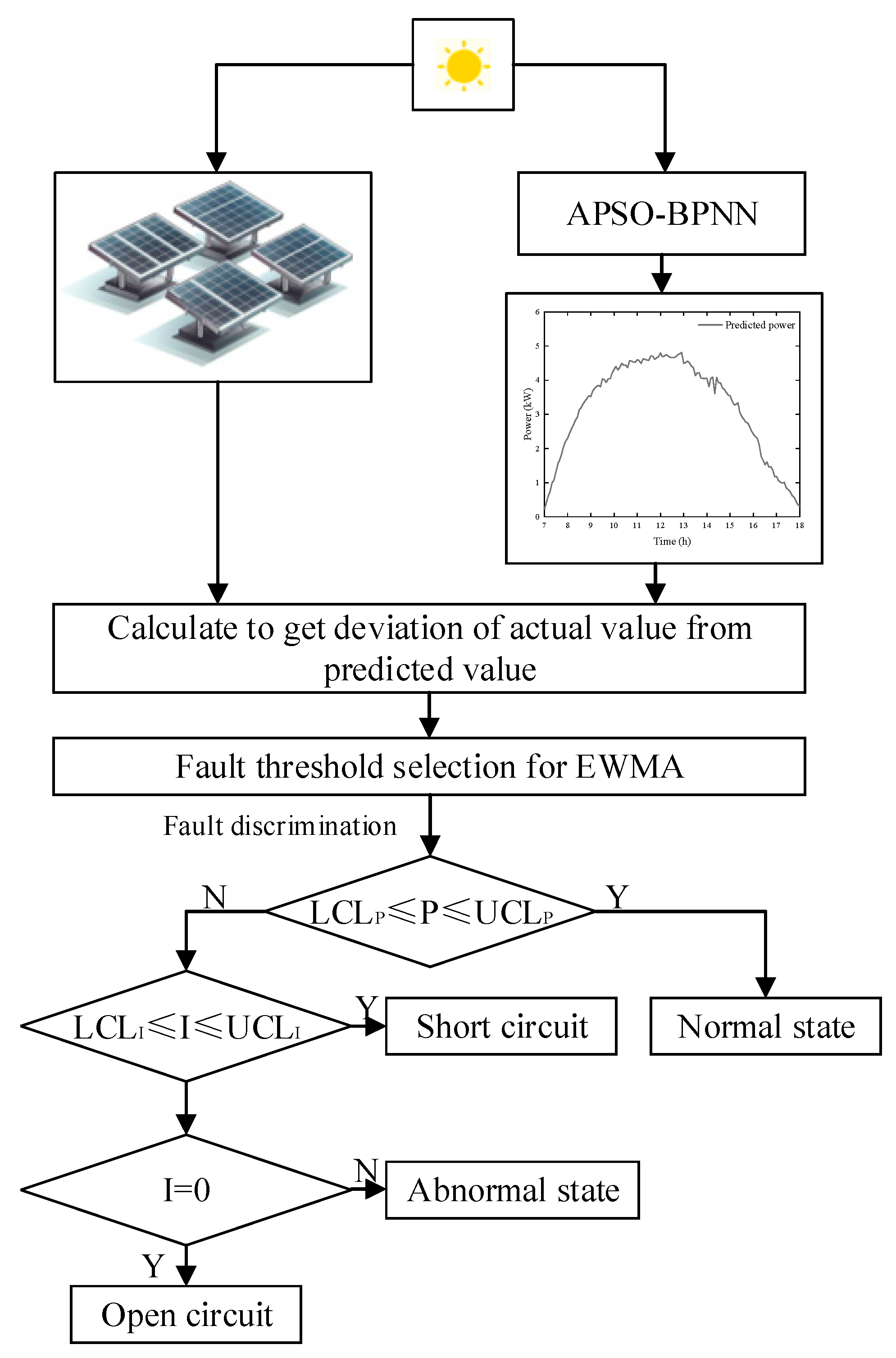





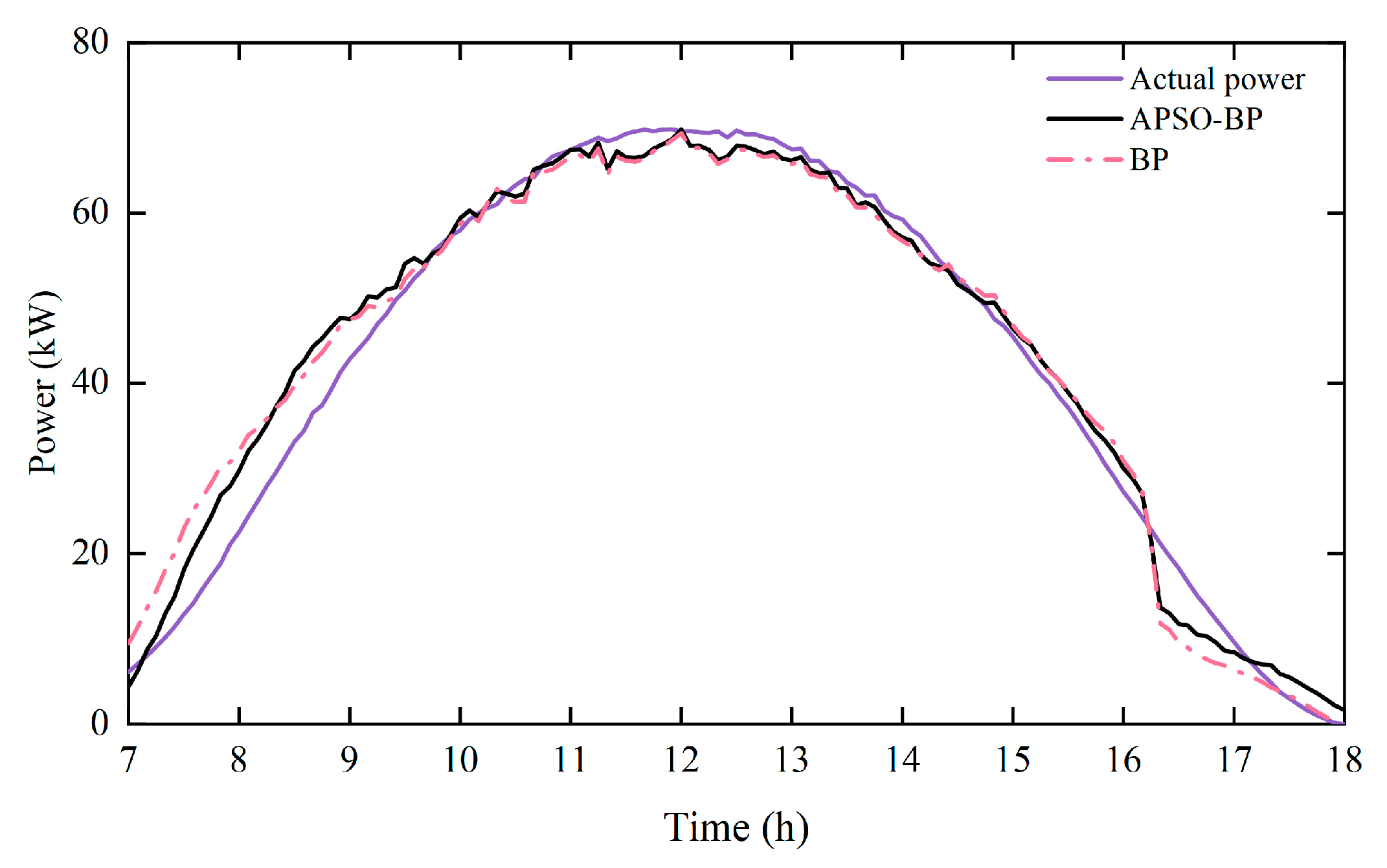

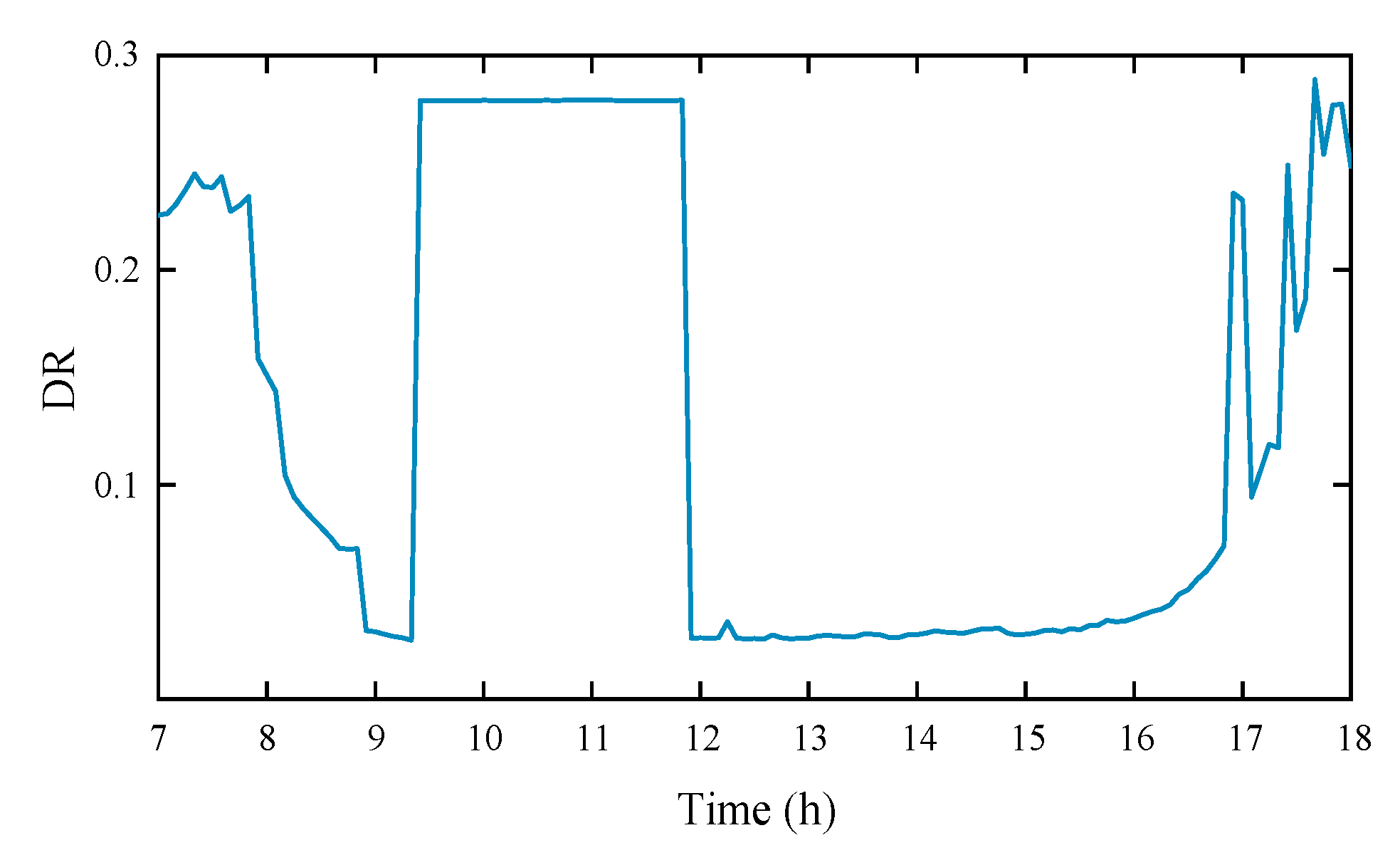
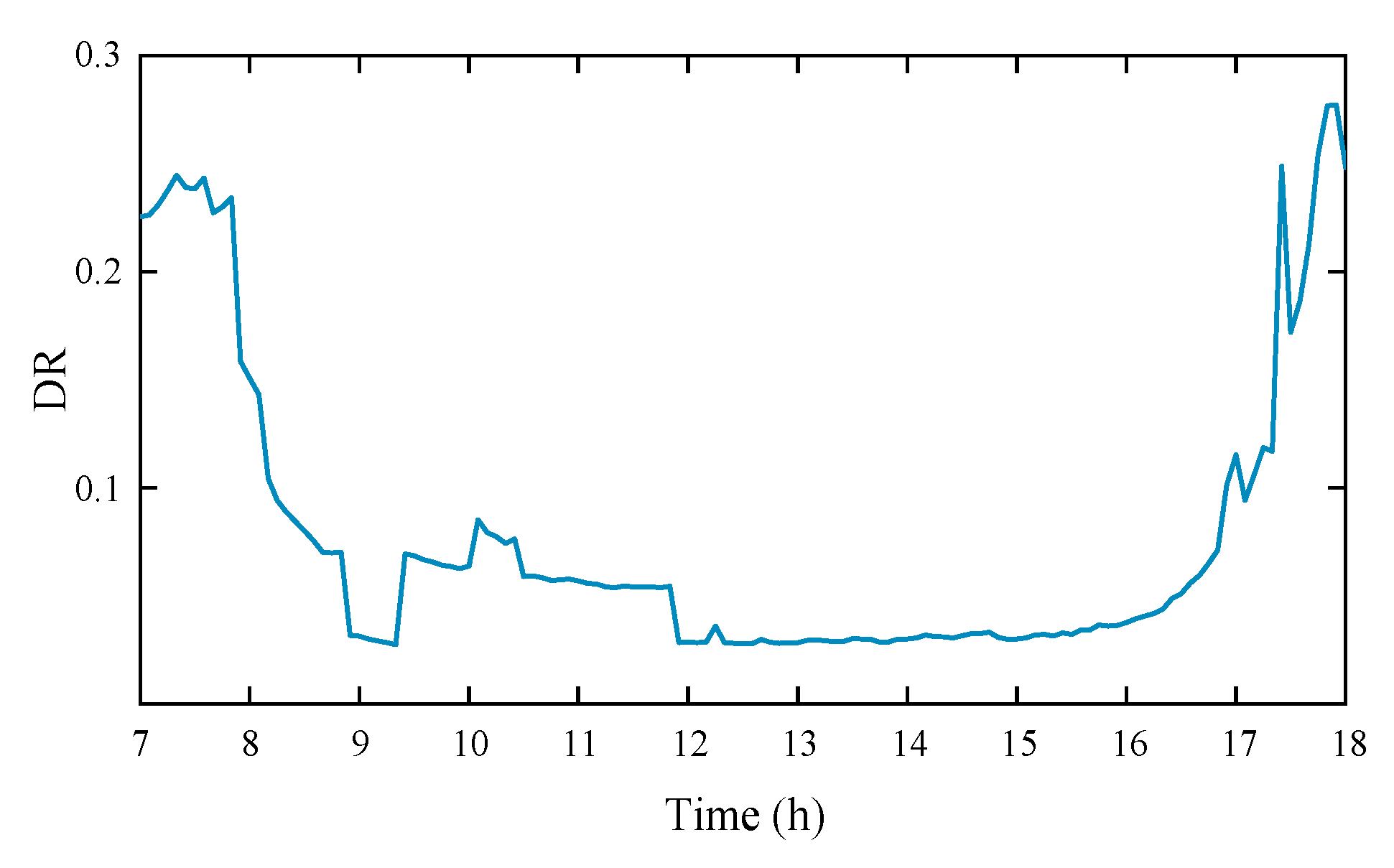
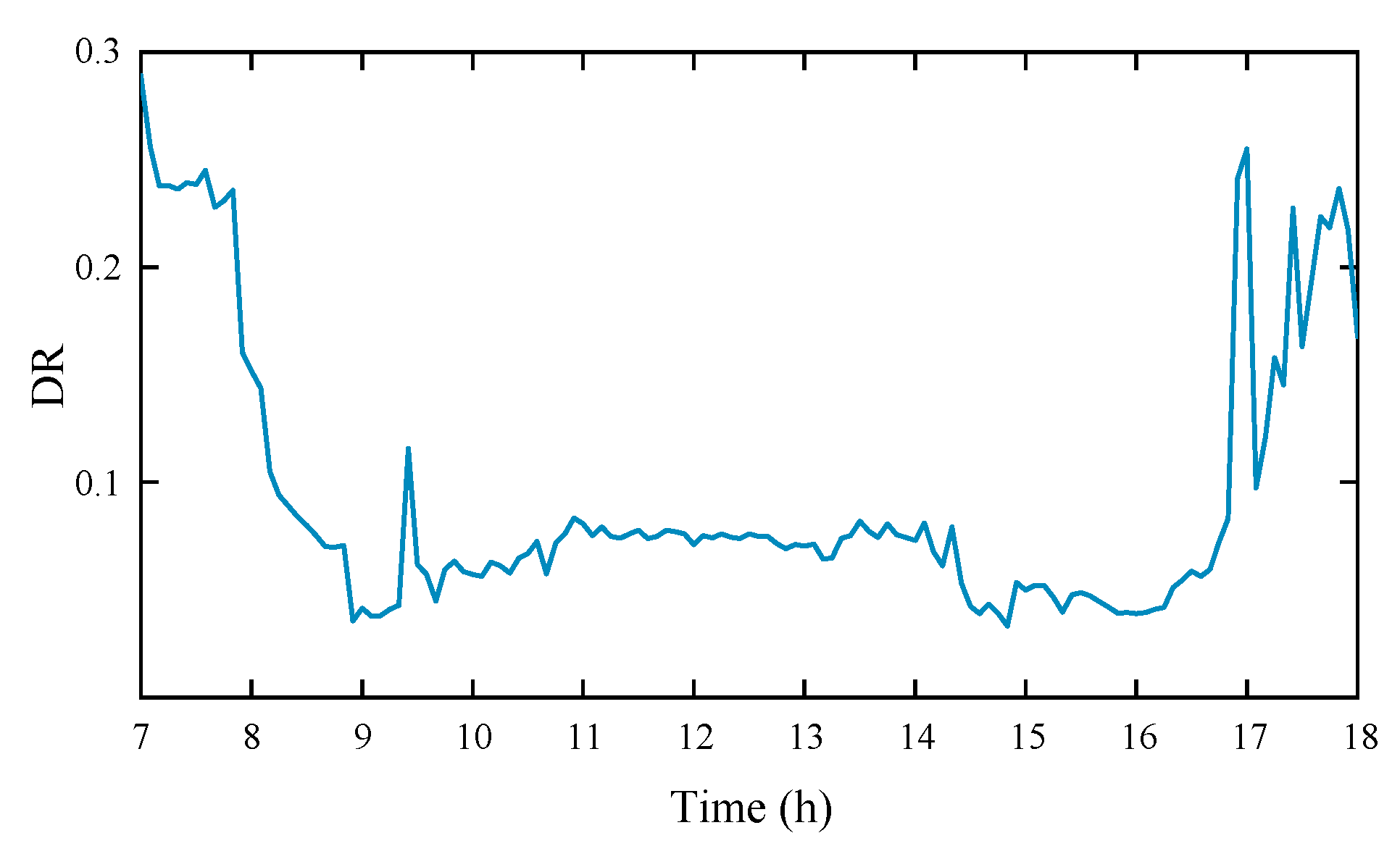
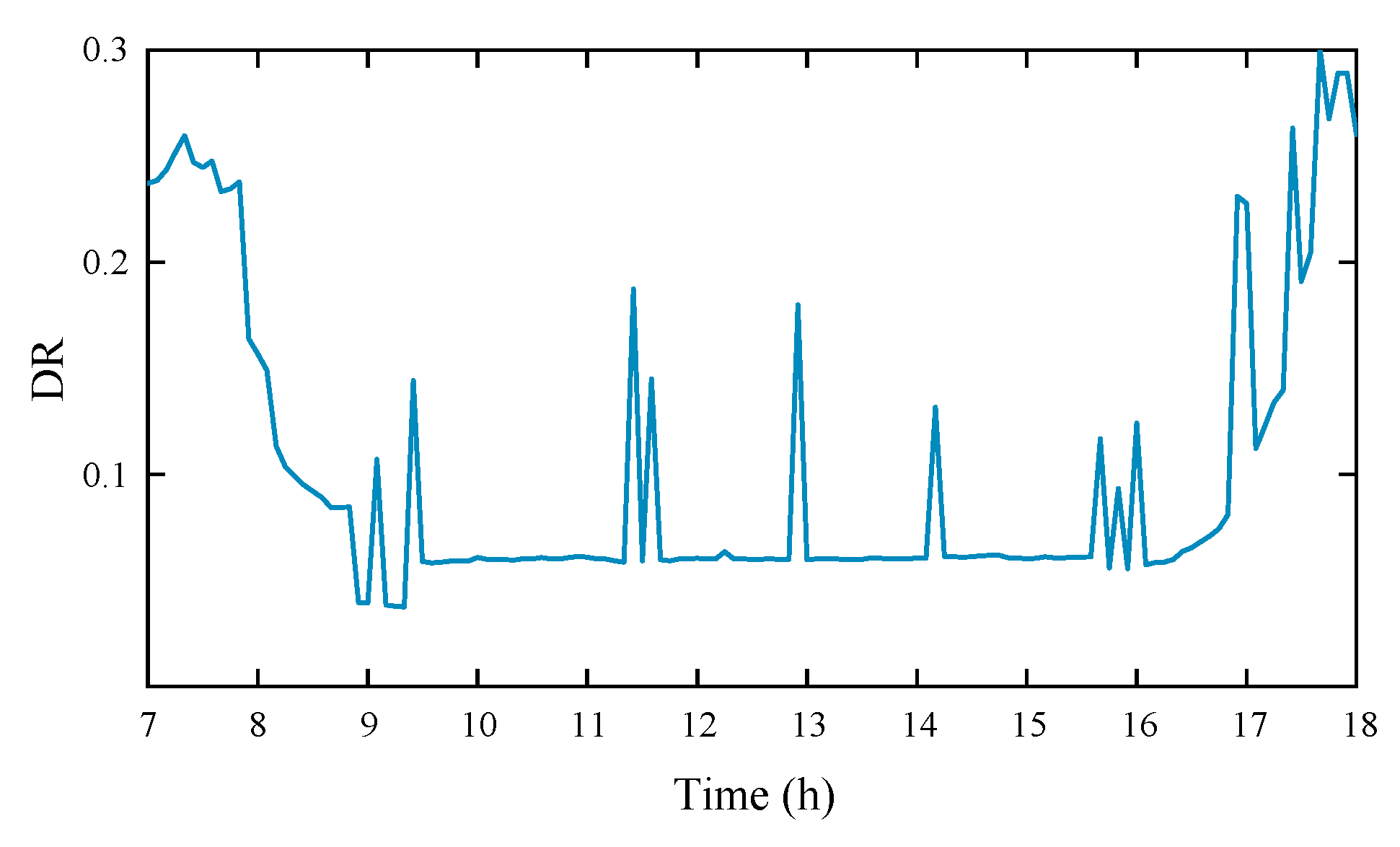

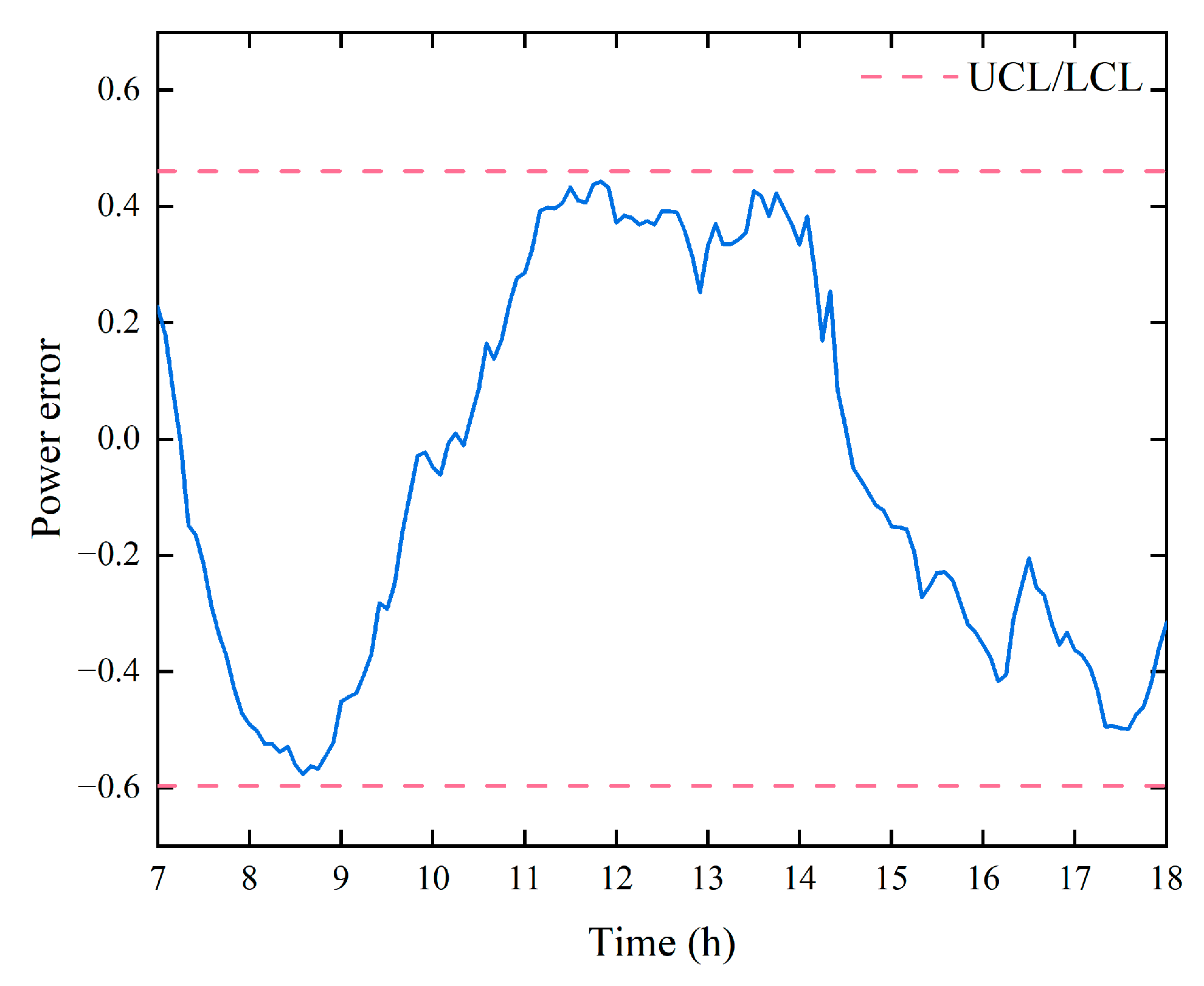
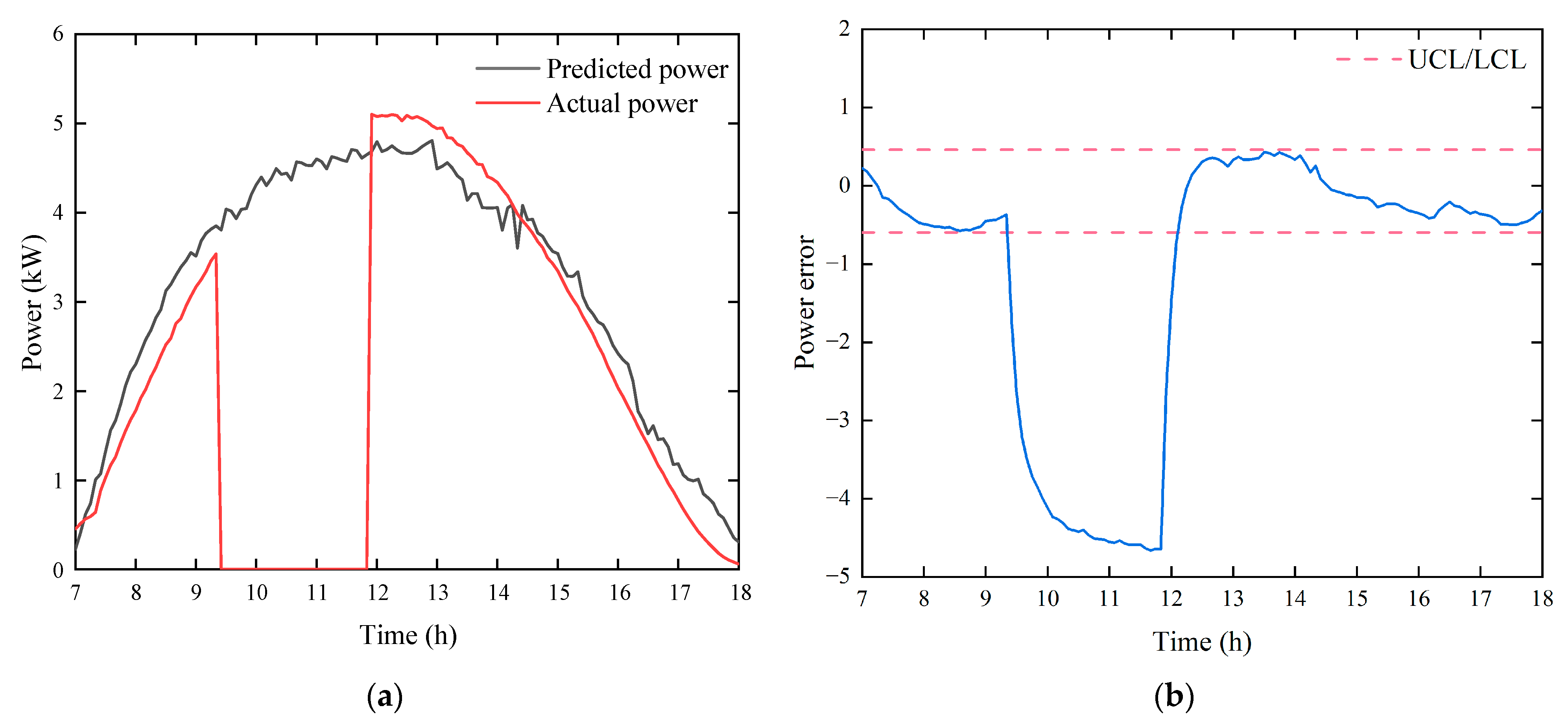

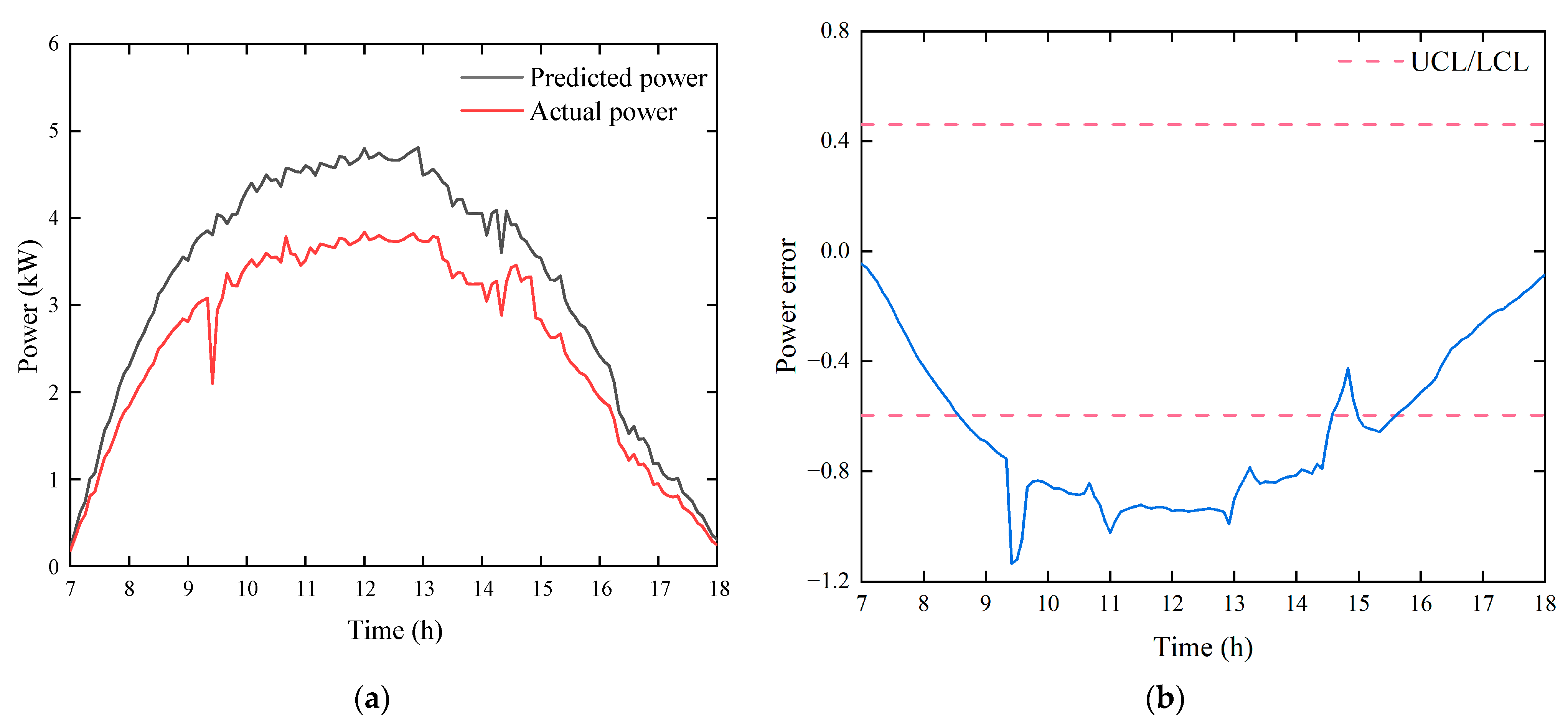
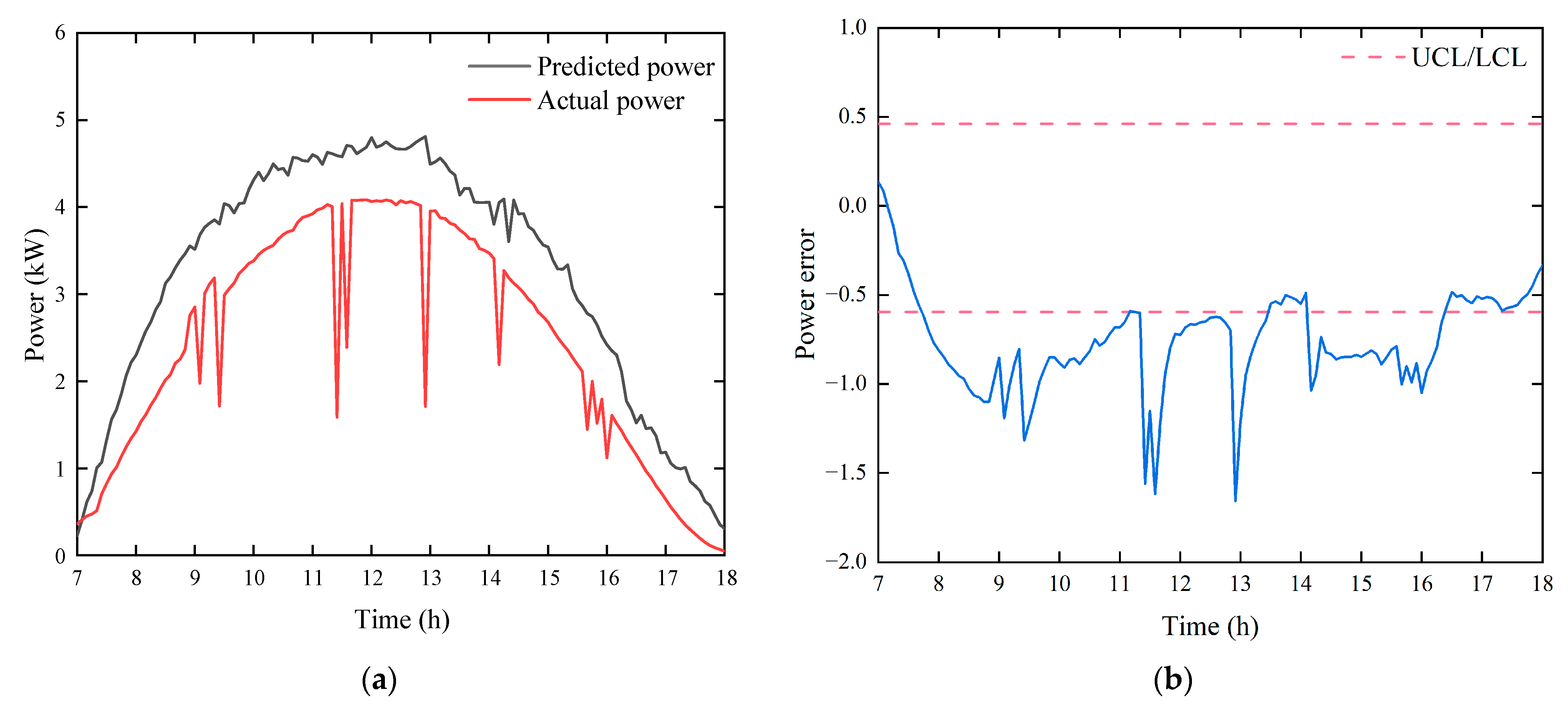


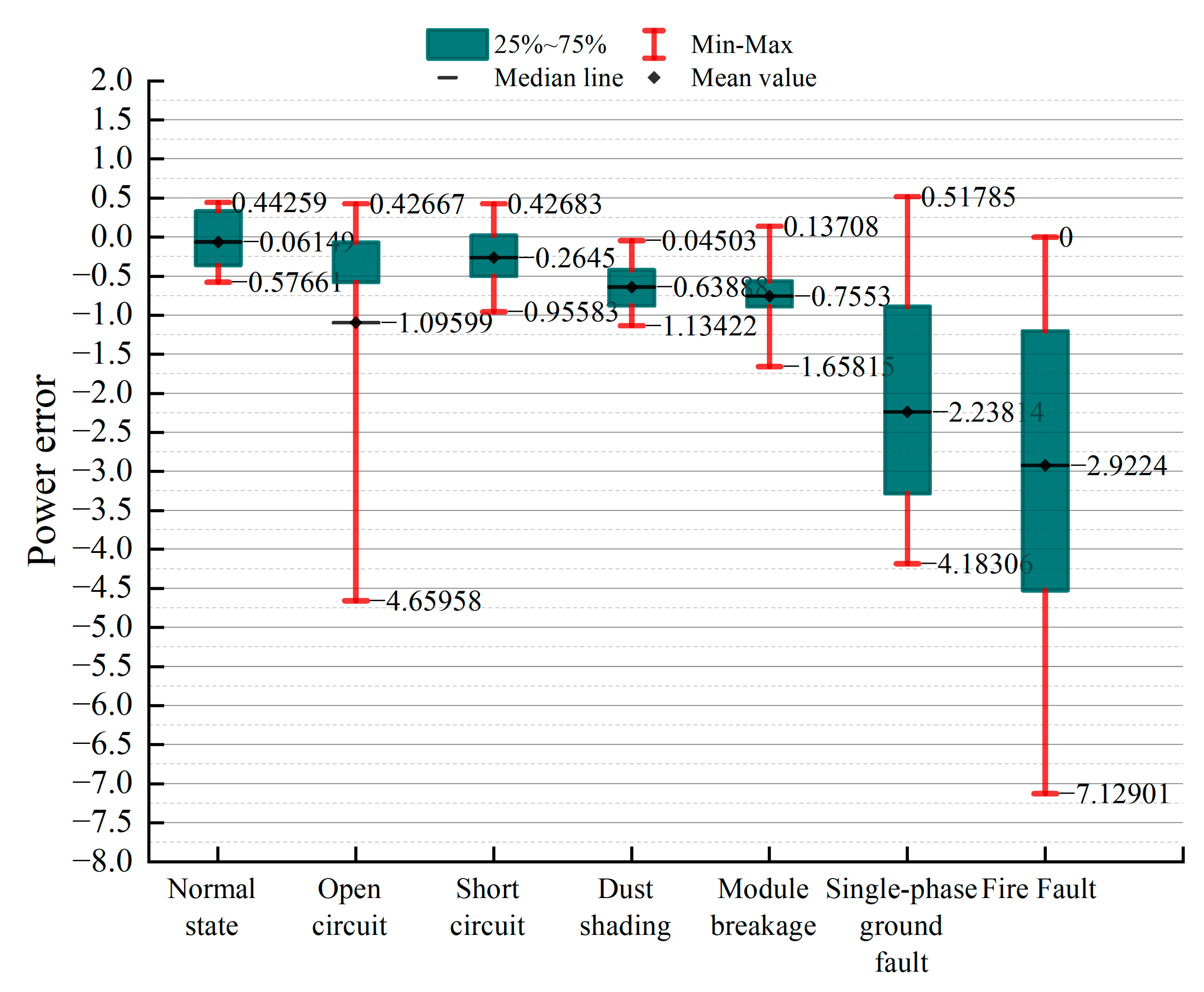
| Metrics | Formula |
|---|---|
| RMSE | |
| MAE |
| Model | RMSE | MAE | |
|---|---|---|---|
| APSO-BP | 0.98 | 3.4 | 2.6 |
| BP | 0.96 | 4.3 | 3.2 |
| Range of Values | State |
|---|---|
| 0–0.05 | Stable |
| 0.05–0.1 | Favourable |
| 0.1–0.2 | Need to improve |
| >0.2 | Poor |
Disclaimer/Publisher’s Note: The statements, opinions and data contained in all publications are solely those of the individual author(s) and contributor(s) and not of MDPI and/or the editor(s). MDPI and/or the editor(s) disclaim responsibility for any injury to people or property resulting from any ideas, methods, instructions or products referred to in the content. |
© 2024 by the authors. Licensee MDPI, Basel, Switzerland. This article is an open access article distributed under the terms and conditions of the Creative Commons Attribution (CC BY) license (https://creativecommons.org/licenses/by/4.0/).
Share and Cite
Su, J.; Zeng, Z.; Tang, C.; Liu, Z.; Li, T. A Photovoltaic Fault Diagnosis Method Integrating Photovoltaic Power Prediction and EWMA Control Chart. Energies 2024, 17, 4263. https://doi.org/10.3390/en17174263
Su J, Zeng Z, Tang C, Liu Z, Li T. A Photovoltaic Fault Diagnosis Method Integrating Photovoltaic Power Prediction and EWMA Control Chart. Energies. 2024; 17(17):4263. https://doi.org/10.3390/en17174263
Chicago/Turabian StyleSu, Jun, Zhiyuan Zeng, Chaolong Tang, Zhiquan Liu, and Tianyou Li. 2024. "A Photovoltaic Fault Diagnosis Method Integrating Photovoltaic Power Prediction and EWMA Control Chart" Energies 17, no. 17: 4263. https://doi.org/10.3390/en17174263
APA StyleSu, J., Zeng, Z., Tang, C., Liu, Z., & Li, T. (2024). A Photovoltaic Fault Diagnosis Method Integrating Photovoltaic Power Prediction and EWMA Control Chart. Energies, 17(17), 4263. https://doi.org/10.3390/en17174263





